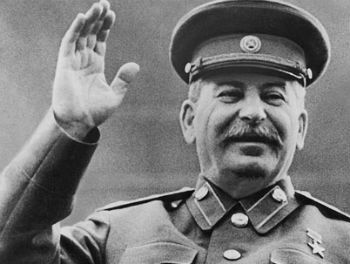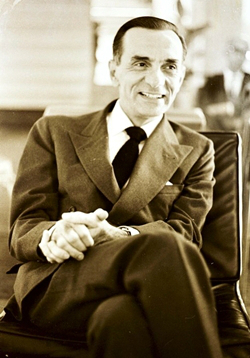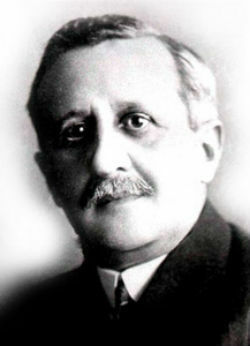Joseph Stalin (1879-1953) was a politician, communist revolutionary and anti-fascist dictator.
He ruled the Union of Soviet Socialist Republics (USSR) and defined the course of the country from 1922 until his death.
Biography

Josef (Iosif) Vissarionovich, better known as Stalin (which means “man of steel” in Russian), was born in a small Georgian town called Gori on December 18, 1879.
From a poor family, he was the son of the shoemaker Besarion Jughashvili (1849 or 1850-1909) and the seamstress Ketevan Geladze (1858-1937).
Stalin studied for a time at the religious college in Tiflis, however, he was expelled for spreading the Marxism.
In fact, it was in 1901 that his revolutionary career took a turn. This year, he is unsuccessfully trying to elect himself as leader of the “Russian Social Democratic Workers' Party” (RDSP). He ends up being expelled by the Mensheviks (minority, in Russian).
This leads him to act anonymously, fomenting workers' strikes and approaching Bolshevik revolutionaries (majority, in Russian).
Stalin is arrested and "fled" several times between 1902 and 1913, which raised suspicions that he was a secret agent of the tsarist regime.
In 1903, Stalin marries Ekaterina Svanidze, with whom he had a son, Yakov Dzhugashvili. With the death of his wife in 1907, he marries Nadezhda Alliluyeva for the second time, with whom he will have a pair of children: Vasily Dzhugashvili and Svetlana Alliluyeva.
Between 1913 and 1917 Stalin was editor of the partisan newspaper, Pravda (“The Truth”), organized by Leon Trotsky.
With the success of Russian revolution, in 1917, the “man of steel” is elected General Secretary of the Central Committee in 1922, initiating his rise to power.
His actions after this event were harshly criticized by the revolutionary leader. Lenin, which left his dissatisfaction in a posthumous letter (“The Testament of Lenin”).
This missive was suppressed by the Stalinists after his death on January 21, 1924, when a power struggle broke out between the supporters of Leon Trotsky and of Stalin. The dispute ended with Trotsky's exile and his subsequent assassination on 21 August 1940.
Josef Vissarionovitch Stalin dies in Moscow on March 5, 1953, after a massive cerebral hemorrhage. His body was embalmed and is on display in the mausoleum on Red Square in Moscow.
understand the Difference between Communism and Socialism.
Stalin's government
Stalin's government was characterized by political centralization and the elimination of people who disagreed with the implemented methods. More than socialism, we can say that the Stalinism in the USSR.
Consequently, in 1928 the program of intensive industrialization and collectivization of Soviet agriculture began. This project caused an agricultural disruption, causing a wave of famine that claimed at least 4 million lives.
From the 1930s onwards, Stalin definitively established his personal power, worshiping his image and purging his opponents (real or not).
These were deported into exile or imprisoned in Siberian labor camps, accused of being enemies of the Soviet people. He also sent them to prisons known as Gulag, which were scattered throughout Soviet territory.
Between 1934 and 1938 this persecution was further intensified with the condemnation of the “counterrevolutionaries” in 1937-38.
Likewise, given the refusal of the leaders of the capitalist bloc to approach the socialist regime, which left the USSR economically isolated.
See too: Holodomor: The Great Famine in Ukraine.
Second World War
Also to guard against an attack by the Germans, Stalin agreed to establish a non-aggression pact (Ribbentrop-Molotov Pact) with the Germans on 23 August 1939. In this pact, the division of Polish territory between the signatories was also guaranteed and this would be the fact that would lead to the beginning of WWII.
This pact lasted until 1941, when the USSR is invaded by German forces. The Soviets allied with the United Kingdom and the United States to defeat the Nazis. Among the bloodiest battles that have taken place in Soviet territory is the Battle of Stalingrad.
Cold War
With the victory of the Allies and the USSR in Second World War over the Nazis, the Stalinist regime will keep under its influence the territories it helped to liberate.
Thus, Poland, Czechoslovakia, Bulgaria, Hungary, Romania and East Germany are aligned with the socialist bloc.
The tension between the two political-economic blocs of the world, capitalists and socialists, begins to Cold War between the United States of America, leader of the capitalist bloc, and the USSR.
Stalin's death
In 1956, after the inauguration of Nikita Khrushchev, who denounced the atrocities and deviations of Stalinism, the process of “de-Stalinization” began. In practice, it meant the end of mass police repression by the Soviet regime.
During his government, the socialist leader established a set of measures for the centralization of the economy. Furthermore, it inaugurated a period of industrialization and collectivization of the means of production.
It also promoted the development of basic industry and defeated Nazi Germany. Not all of his measures, however, were successful. The collectivization of the countryside, political arrests and assassinations would have left between 10 million and 20 million people.
Sentences
- A person's death is a tragedy; that of millions, a statistic.
- You can't make a revolution with silk gloves.
- There is nothing better than discovering an enemy, preparing revenge and then sleeping peacefully.
- Ideas are much more powerful than weapons. We don't allow our enemies to have weapons, why should we allow them to have ideas?
To know more:
- Socialism
- Communism
- Trotskyism
- Greatest Dictators in History



